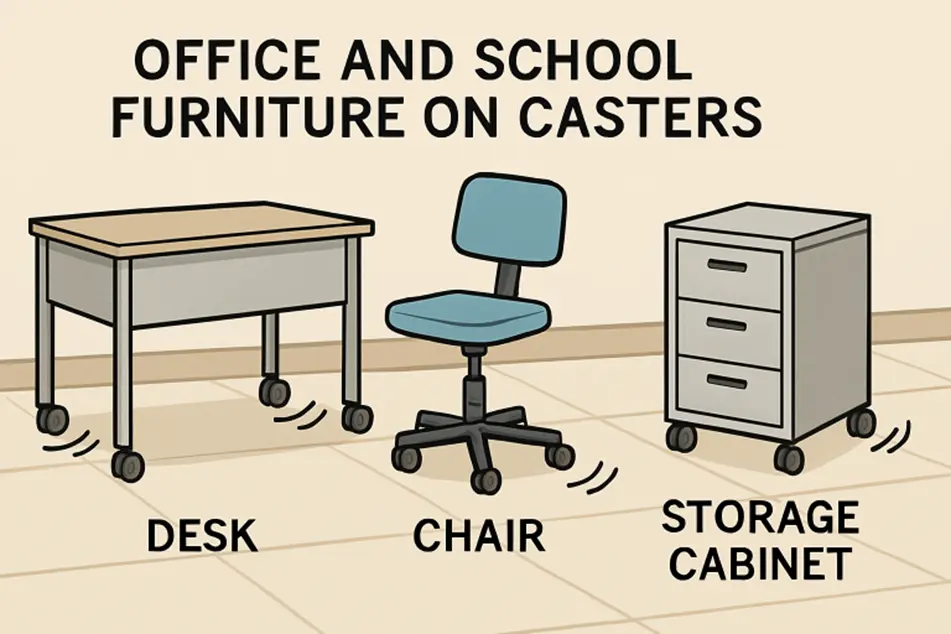Safe and Smart Uses for Casters in Schools and Workspaces
Enhancing Classroom Flexibility
The modern classroom is evolving to meet the demands of dynamic learning environments. Today’s educational spaces require constant adaptation—not just in teaching styles but also in their physical layouts. Mobile furniture outfitted with casters allows educators to quickly and efficiently rearrange desks, tables, and chairs to suit various instructional methods. Instead of wrestling with heavy or awkward pieces, staff can smoothly glide furnishings into new configurations as needed, making it easier to support varying classroom activities.
Whether teachers need to group students for collaborative projects, clear space for interactive lessons, or create testing zones, the ability to glide furnishings into place saves valuable time and effort that can be better spent on teaching and learning. This mobility also supports project-based work and rotating group stations, helping to foster a more engaging, active environment for students. Schools can accommodate traditional and innovative teaching techniques by shifting layouts to the day’s lesson plan.
Selecting the correct type of casters ensures mobility without sacrificing stability or floor protection. For example, 5 inch caster wheels are ideal for accommodating moderate to heavy loads typical in educational settings while offering reliable maneuverability. These casters often feature non-marking treads and locking mechanisms, preventing unwanted movement during activities or assessments. This versatility empowers staff to transform static classrooms into adaptable zones, encouraging engagement and active learning.
Improving Workplace Ergonomics
In business and administrative environments, healthier, safer workplaces are a growing priority. Ergonomic improvements begin with reducing physical strain on employees, especially when moving equipment and heavy supplies. High-quality casters lower the force required to move furniture, minimizing the risk of musculoskeletal disorders and workplace injuries. By making even heavy file cabinets, printers, or cubicle walls easier to reposition, casters help keep the workplace flexible and accessible.
According to the Occupational Safety and Health Administration, such changes prevent injuries and contribute to higher productivity and job satisfaction. Employees who can easily adjust their workstations or relocate equipment report better comfort and efficiency, and companies benefit from fewer lost workdays due to strain or injury. Ergonomics isn’t just about posture—it extends to all elements that make movement safer and less taxing.
Integrating tailored caster solutions addresses distinct workplace requirements. For instance, soft-tread casters safeguard delicate flooring in offices, while heavy-duty options keep equipment mobile in production spaces. In hospital or laboratory settings, specialized medical casters provide smooth, quiet motion that reduces the risk of spills or disruptions. Creating a culture centered on safety and efficiency can be as simple as ensuring employees have access to furniture equipped with suitable, easy-rolling casters that fit the specific context of their routine tasks.
Choosing the Right Casters
Not every caster is created equal; selecting the correct type for your specific environment is paramount. Casters come in various materials: rubber, polyurethane, metal, and even specialty blends designed to prevent static or resist chemicals. Considerations should always include weight capacity, wheel diameter, tread material, and compatibility with existing flooring. For instance, larger wheels typically roll more easily over uneven surfaces, while softer treads help prevent scratches on hardwood.
Casters that are too small or underrated for a particular load may create hazards by increasing toppling risks or creating friction damage to floors. Additionally, the wrong tread can wear out quickly or cause noise that disrupts work or learning. It’s important to choose the correct mounting style—plate, stem, or threaded—to ensure a secure fit with your furniture.
For example, large office chairs often feature casters rated for carpet and hard surfaces, ensuring users can move smoothly regardless of floor type. Industrial carts that must traverse thresholds or ramps require heavy-duty casters with specific load ratings. Referencing expert guides or consulting with professionals can help avoid costly mistakes and ensure long-term satisfaction with your choice of casters.
Maintenance and Safety Considerations
While casters and mobile furniture make spaces more versatile, ensuring their safety requires proactive care and regular maintenance. Over time, debris, dust, and hair can accumulate in the wheel housings, leading to decreased performance or immobilization. Regularly inspecting casters for signs of wear, such as flat spots, loosened bolts, or broken seals, helps prevent potential hazards before they arise. Developing a simple maintenance schedule is a good idea so issues are caught and corrected early.
Cleaning dust and debris from wheel housings and lubricating moving components with the appropriate oil as needed ensures quiet and smooth operation. Tightening any loose bolts and checking that locks engage properly adds an extra layer of safety, especially in busy environments where equipment gets heavy use.
Additionally, it’s essential to train staff and students on safe movement practices, such as not exceeding weight ratings or riding on furniture intended only for transport. Overlooking these small but crucial steps can lead to malfunction, increased repair costs, or even direct safety hazards. According to Safety+Health Magazine, regular preventative maintenance is one of the best ways to improve product lifespan and user safety. Developing clear protocols for reporting and repairing damaged casters is essential in schools and workplaces.
When to Avoid Casters
While the advantages are significant, casters aren’t universally suitable. Lightweight furniture may become unstable if set on casters, posing tipping hazards that could lead to injury or damage, especially in busy, high-traffic environments. In some cases, constant movement creates distractions or disrupts structured spaces needed for concentration.
Some spaces benefit from fixed furnishings to preserve order, control traffic flow, or for security purposes. For example, computer labs and libraries often use stationary desks to maintain consistent layouts and prevent unnecessary shifting. Situations where property security is a concern may also call for bolted-down furniture to discourage tampering or theft.
Assess each piece of furniture and its intended use before installation. In many cases, stationary solutions are preferable for maintaining structure and minimizing distractions in environments where stability is key. Consider alternatives such as glides or skid-resistant feet when flexibility is not the top priority, ensuring long-term safety and consistency.
Conclusion
Casters are powerful tools for creating adaptive, user-friendly schools and workplaces. When thoughtfully selected and maintained, they offer clear benefits—from invigorating teaching spaces to making offices safer and more comfortable. Taking the time to assess the needs of every environment, choosing the right models, and ensuring proper care will foster the kind of dynamic, productive spaces that modern users expect.
Also Read-From Diets to Daily Life: 300 Grams Explained With Shocking Facts and Real Examples

